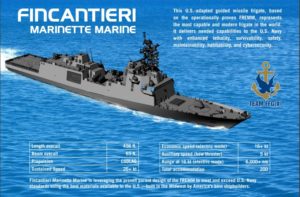The final defense appropriations bill allows certain parts of the new FFG(X) future frigate program to be supplied from foreign sources, but requires a study on incorporating certain domestic components in later hull numbers.
In June, Rep. Mike Gallagher (R-Wis.) offered an amendment to the House Armed Services Committee Seapower and Projection Forces version of the defense authorization bill that allows the Navy to award a contract that does not domestically source propulsion or certain auxiliary equipment. This aimed to get around a “Buy America” provision for the frigate in an earlier version of the the defense appropriations bill.

At the time, he explained while the subcommittee supported Buy America provisions for other ships likes auxiliary vessels, it would have “devastating consequences” on warships like frigates.
“Essentially, we don’t impose that restriction on any warships we have right now,” he said.
Gallagher warned the provision could exclude four of the five competitors from the frigate competition, increase costs and delay the award by at least one year.
The defense appropriations conference report noted while it will not push the provision now, it still has “concerns with the dependence of the Department of the Navy to source surface ship components from foreign industry partners rather than promote a robust domestic industrial base.”
In exchange for removing the Buy America provision to procure certain components for the FFG(X) program from non-U.S. suppliers on the initial contract, the Secretary of the Navy is directed to incorporate U.S.-manufactures propulsion engines and propulsion reduction gears into the program by the 11th frigate.
The Secretary is also “directed to conduct a study on the impacts of incorporating United States manufactured propulsion engines and propulsion reduction gears into the FFG(X) Frigate program prior to the eleventh ship, and to submit the study to the congressional defense committees not later than 180 days after the contract award of the FFG(X) Frigate.”
The study should include estimates of potential changes to the acquisition schedule and associate costs with incorporating domestically produced equipment into the FFG(X) program with the fourth, sixth, eight, 10th, and 11th ships in the program.
The bill also says the Navy Secretary “is encouraged” to support a robust domestic industrial base with more stringent contract requirements in future surface ships classes.
If funded for FY 2020, the Navy plans to award the detail design and construction contract for up to 10 FFG(X) frigates by July 2020. The service expects to eventually procure up to 20 frigates.
The Navy issued the final request for proposals in June after concluding a 16-month-long conceptual design (CD) contract period with five companies to help reduce risk and mature designs faster (Defense Daily, June 21).
The five CD companies were Lockheed Martin [LMT], Austal USA, Huntington Ingalls Industries [HII], Lockheed Martin [LMT], Fincantieri Marinette Marine, and General Dynamics’ Bath Iron Works [GD].
In May, Lockheed Martin dropped out of the frigate competition. At the time, a spokesperson told Defense Daily the company decided to focus instead of frigate combat systems like the Aegis-derived MK 41 Vertical Launching Systems, electronic warfare, and anti-submarine warfare processing (Defense Daily, May 29).